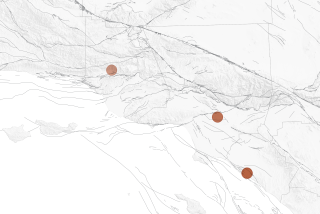Part of fault may be less of a threat, professor says
- Share via
The northern portion of the Newport-Inglewood fault, which appeared to rupture in Sunday’s magnitude 4.7 quake, is believed to be less prone to large, destructive earthquakes than the fault’s southern portion, USC professor James Dolan said Monday.
The Newport-Inglewood fault, counting its southern continuation, known as the Rose Canyon fault, is about 150 miles long and runs from Baldwin Hills to the Mexican border.
Such a fault is capable of generating earthquakes of magnitude 7 and above, but the part that includes Lennox, where Sunday’s quake was centered, is “kind of a separate beast,” said Dolan, a professor of earth sciences at USC.
The 20-mile stretch from Baldwin Hills to Long Beach is composed of several smaller cracks that run loosely parallel to one another, Dolan said. They have not yet coalesced into a basically smooth, single crack like the San Andreas, where seismic waves have a much easier time rippling through the earth for longer distances and causing larger quakes.
Sunday’s quake did not appear to significantly redistribute the stresses on the Newport-Inglewood fault, but Dolan said he is also keeping an eye on its effect on the nearby Compton blind thrust fault. That fault, he said, is also believed to be capable of generating quakes above magnitude 7.
--
More to Read
Sign up for Essential California
The most important California stories and recommendations in your inbox every morning.
You may occasionally receive promotional content from the Los Angeles Times.













